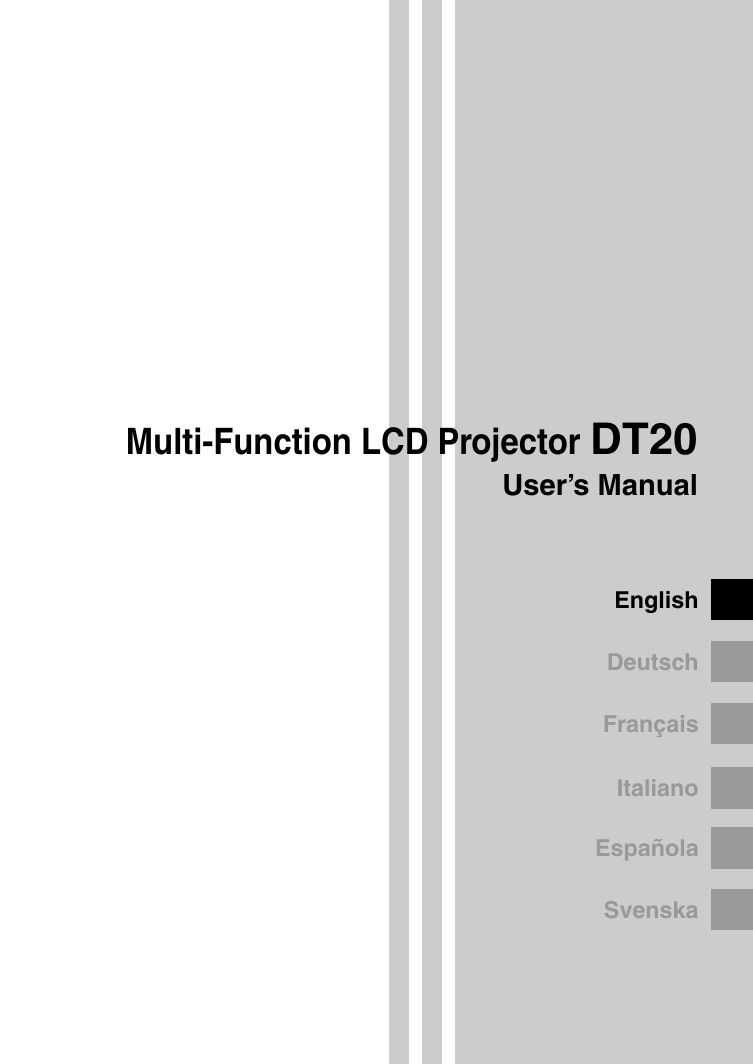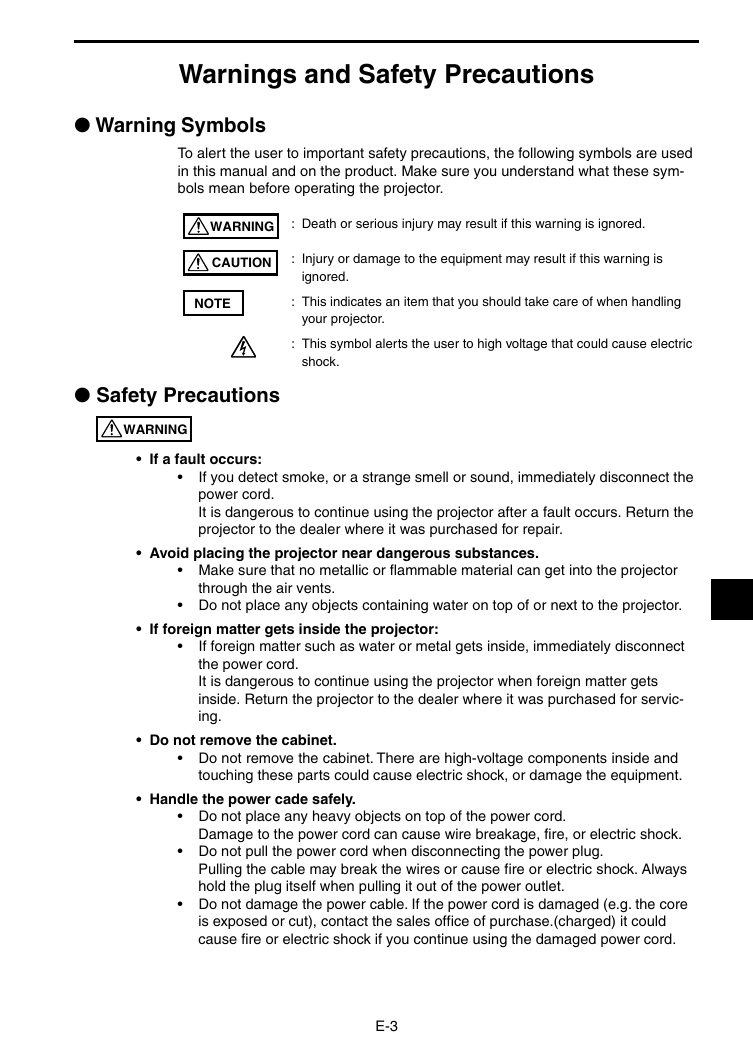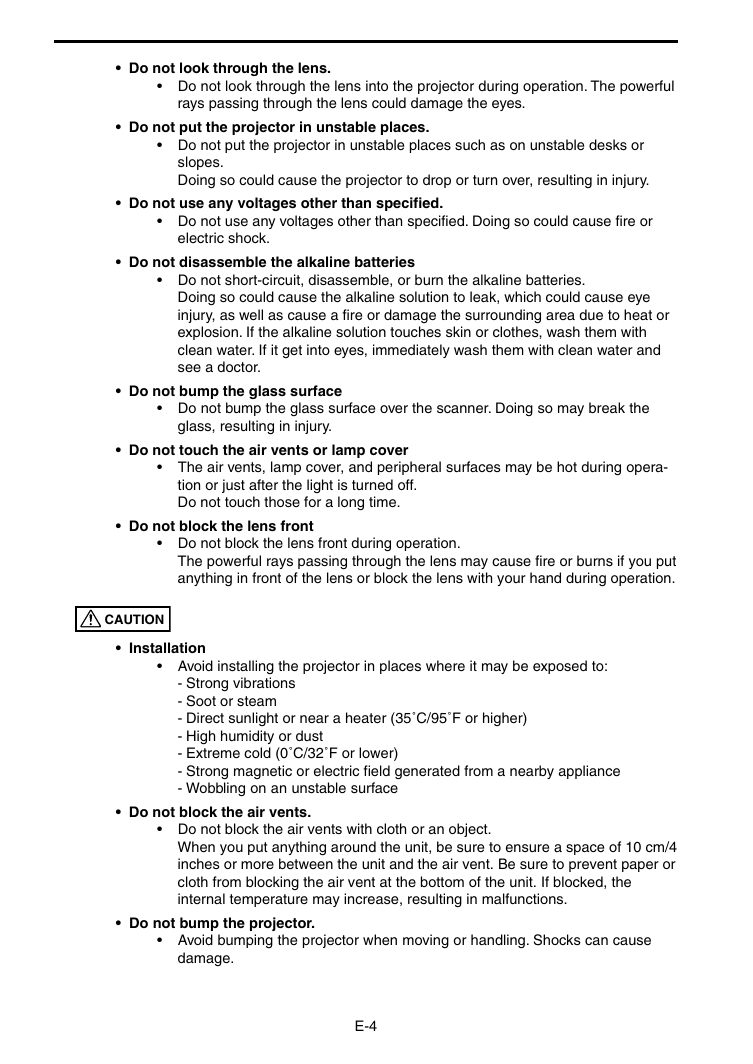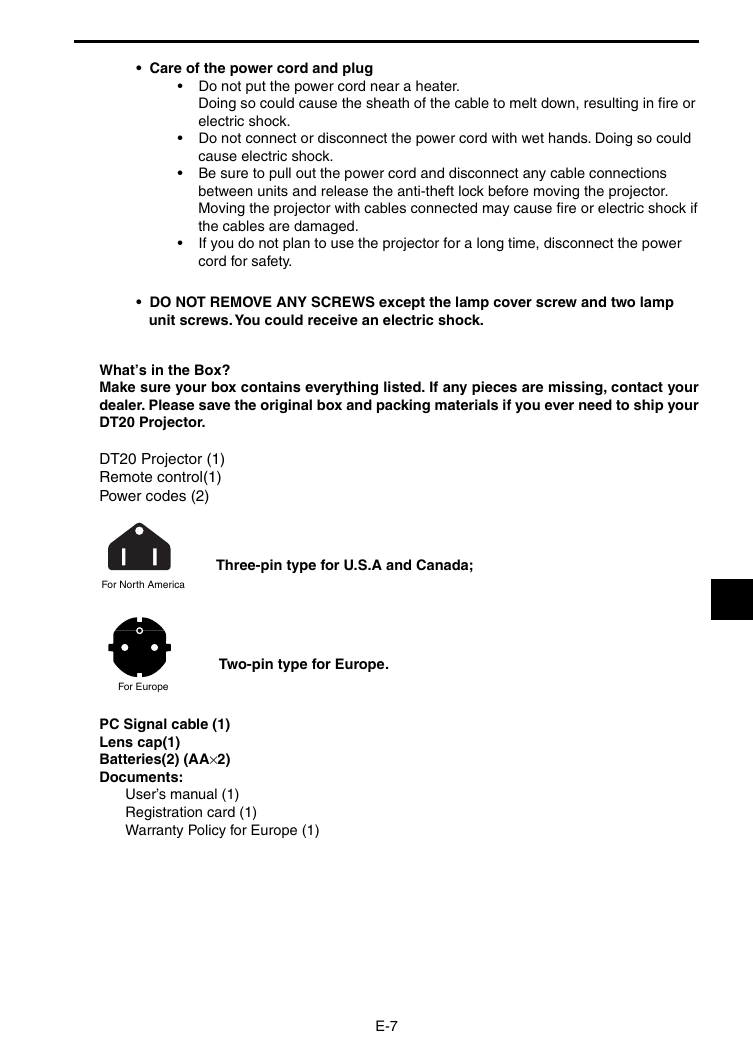Multi-Function LCD Projector DT20
User’s Manual
English
Deutsch
Français
Italiano
Española
Svenska
�
Thank you for purchasing the NEC DT20 LCD Projector.
Please read this manual carefully in order to use the projector properly.
After reading this, please keep it in a safe place together with the warranty sheet.
● Features
• Three handy features in a single body. The projector for the multimedia age
1. Documents, catalogs and other printed matter can be projected directly from
the scanner. This frees the user from the need to make OHP film inserts for
each document.
2. Personal computer screens can be projected. This allows the user to make
detailed presentations using information on a personal computer.
3. Videos and DVD images can be projected as they are. This aids the user in
making visually appealing presentations.
• Easy-to-understand and simple operation
Projection of printed matter, personal computer screens and video images can
be selected at the push of a button.
• High cost effective resource-saving design
OHP film inserts no longer need to be made, which saves wasted time and
expense.
•
“Super-Slim” Stylish Body
Full OHP functions based on advanced technology built in to a super-slim
chassis. It fits anyplace, when you’re using it, and when you need to put it away.
• Expressive color images
The projector is equipped with a high-resolution 2 million pixel single-array color
CCD camera. This allows subtle midtones in color documents to be reproduced
faithfully and sharp as projected images in full color (16,770,000 colors).
• Enlarged display without changing the size of the projected image
When projecting documents such as catalogs and word-processor documents
containing small text that have not been made specially for presentations, the
document can be enlarged without changing the size of the projected image for
easier viewing.
• Provided with display functions for compressed or enlarged PC screen
Screens of resolution more than 1024 x 768 dots are displayed compressed to
1024 x 768 dots without any loss in character quality. Lower resolutions such as
640 x 480 can also be enlarged to 1024 x 768 dots.
● About Trademarks
IBM and PC/AT are trademarks or registered trademarks of International Business
Machines Corporation.
Macintosh and Power Book are trademarks of Apple Computer Inc.
Windows is a trademark of U.S. Microsoft Corporation.
E-2
�
Warnings and Safety Precautions
● Warning Symbols
To alert the user to important safety precautions, the following symbols are used
in this manual and on the product. Make sure you understand what these sym-
bols mean before operating the projector.
WARNING : Death or serious injury may result if this warning is ignored.
CAUTION
NOTE
: Injury or damage to the equipment may result if this warning is
ignored.
: This indicates an item that you should take care of when handling
your projector.
: This symbol alerts the user to high voltage that could cause electric
shock.
● Safety Precautions
WARNING
• If a fault occurs:
•
If you detect smoke, or a strange smell or sound, immediately disconnect the
power cord.
It is dangerous to continue using the projector after a fault occurs. Return the
projector to the dealer where it was purchased for repair.
• Avoid placing the projector near dangerous substances.
• Make sure that no metallic or flammable material can get into the projector
through the air vents.
• Do not place any objects containing water on top of or next to the projector.
• If foreign matter gets inside the projector:
•
If foreign matter such as water or metal gets inside, immediately disconnect
the power cord.
It is dangerous to continue using the projector when foreign matter gets
inside. Return the projector to the dealer where it was purchased for servic-
ing.
• Do not remove the cabinet.
• Do not remove the cabinet. There are high-voltage components inside and
touching these parts could cause electric shock, or damage the equipment.
• Handle the power cade safely.
• Do not place any heavy objects on top of the power cord.
Damage to the power cord can cause wire breakage, fire, or electric shock.
• Do not pull the power cord when disconnecting the power plug.
Pulling the cable may break the wires or cause fire or electric shock. Always
hold the plug itself when pulling it out of the power outlet.
• Do not damage the power cable. If the power cord is damaged (e.g. the core
is exposed or cut), contact the sales office of purchase.(charged) it could
cause fire or electric shock if you continue using the damaged power cord.
E-3
�
• Do not look through the lens.
• Do not look through the lens into the projector during operation. The powerful
rays passing through the lens could damage the eyes.
• Do not put the projector in unstable places.
• Do not put the projector in unstable places such as on unstable desks or
slopes.
Doing so could cause the projector to drop or turn over, resulting in injury.
• Do not use any voltages other than specified.
• Do not use any voltages other than specified. Doing so could cause fire or
electric shock.
• Do not disassemble the alkaline batteries
• Do not short-circuit, disassemble, or burn the alkaline batteries.
Doing so could cause the alkaline solution to leak, which could cause eye
injury, as well as cause a fire or damage the surrounding area due to heat or
explosion. If the alkaline solution touches skin or clothes, wash them with
clean water. If it get into eyes, immediately wash them with clean water and
see a doctor.
• Do not bump the glass surface
• Do not bump the glass surface over the scanner. Doing so may break the
glass, resulting in injury.
• Do not touch the air vents or lamp cover
• The air vents, lamp cover, and peripheral surfaces may be hot during opera-
tion or just after the light is turned off.
Do not touch those for a long time.
• Do not block the lens front
• Do not block the lens front during operation.
The powerful rays passing through the lens may cause fire or burns if you put
anything in front of the lens or block the lens with your hand during operation.
CAUTION
• Installation
• Avoid installing the projector in places where it may be exposed to:
- Strong vibrations
- Soot or steam
- Direct sunlight or near a heater (35˚C/95˚F or higher)
- High humidity or dust
- Extreme cold (0˚C/32˚F or lower)
- Strong magnetic or electric field generated from a nearby appliance
- Wobbling on an unstable surface
• Do not block the air vents.
• Do not block the air vents with cloth or an object.
When you put anything around the unit, be sure to ensure a space of 10 cm/4
inches or more between the unit and the air vent. Be sure to prevent paper or
cloth from blocking the air vent at the bottom of the unit. If blocked, the
internal temperature may increase, resulting in malfunctions.
• Do not bump the projector.
• Avoid bumping the projector when moving or handling. Shocks can cause
damage.
E-4
�
• Care of the projector
• To prevent risk of accidents, always disconnect the power plug before clean-
ing the projector.
• Clean the lens surface with a commercial blower or lens cleaning paper.
Wiping with tissue paper or a handkerchief can damage the lens.
• To clean the cabinet, operation panel, and glass surface, wipe gently with a
soft cloth. For particularly dirty spots, soak the cloth in a neutral detergent
mixed in water, wring out well and wipe off the dirt, then use a dry cloth to
wipe dry.
• Do not wipe the projector with any volatile solvent such as benzine or thinner.
Solvents can cause surface deformation or flaking of the paint.
If using an impregnated cloth, follow the instructions.
• Avoid scratching the glass surface.
• Take care not to scratch the glass surface of the scanner with hard or pointed
objects.
Scratches on the glass may distort the projected image.
• Batteries
• When inserting batteries in the remote control, note the polarity (plus and
minus signs) and insert correctly as indicated. Inserting a battery in a wrong
direction can cause rupture or leakage, and could result in fire and injury or
soil the surrounding area.
• Do not use batteries other than the type specified for the equipment. Do not
use a new battery and an old battery together. Incorrect battery usage could
result in rupture or leakage, and could cause fire and injury.
• Do not heat, break open, burn, or immerse the batteries. Battery rupture or
leakage could cause fire and injury.
• Servicing and cleaning
• Have the internal components cleaned by a retailer about once a year. There
is a risk of fire or faulty operation if the inside of the projector gets dusty and
is not cleaned for a long time. For best results, the projector should be
serviced before the wet season brings damp conditions. Cleaning charges
are at the discretion of the retailer.
• If not using the projector for a long period:
•
If you do not plan to use the projector for a long time, disconnect the power
cord for safety.
• Disposal
• Follow the recommendations of your local authority when disposing of the
projector.
• Transporting the projector
• Use the special packaging when transporting the projector. The manufacturer
cannot accept responsibility in the event of damage or accident if other
packaging is used.
• Use the special packaging no more than two times. Repeated usage reduces
the shock absorbency of the packaging and can lead to damage or accident.
• Contact the retailer if you require new packaging.
• Lamp implosion
• An AC type New Super High pressure lamp is used in this projector and it is
rare for the lamp to explode during use. The lamp is also designed to forcibly
turn off because there is a high possibility that the lamp will break if it is used
beyond the lamp usage of 1500 hours (Refer to pages E-54 and E-55).
E-5
�
Note the following things
• A noise occurs because the internal pressure of the New Super High pres-
sure lamp gets extremely high.
The unit is designed so that no pieces of glass come out of it when the lamp
explodes.
• However, the gas inside of the lamp can escape and looks like white smoke.
It will not cause any fire.
Remedy
•
If a lamp explodes in a product, there will be pieces of lamp inside. Do not
replace the lamp. Return the product to the sales office or agent of purchase.
Even though the lamp has exploded, never try to replace the lamp by your-
self. The lamp pieces could cause injury.
• Replacing the lamp
• Be sure to turn the lamp off and disconnect the power cord when the fan
stops, and wait an hour or more before replacing the lamp.
Replacing the lamp during operation or just after the power is turned off may
cause burns due to heat.
Refer to “Lamp Unit Replacement” on page E-54 for the procedure.
• Replacing / cleaning the air filter
• Be sure to disconnect the power cord when the cooling fan stops before
removing the air filter.
Removing the air filter while the cooling fan is rotating could cause a burn.
Refer to “Cleaning the Air Filter” on page E-56 for the procedure.
• Avoiding malfunctions and accidents
• Adjust the Adjustable feet to keep the projector horizontal.
Using the projector in a tilted status may cause injury if it turns over. Refer to
“Adjusting the Tilt” on page E-18 for the adjusting procedure.
• Do not disassemble the manganese batteries
•
Do not short-circuit, disassemble, or burn the manganese batteries.
Doing so could cause the batteries to generate heat or explode due to the
leaked solution, resulting in fire, injury, or damages to the surrounding area.
• Do not do the followings
• Do not put anything heavy on the projector.
• Do not step on the projector, rack, or stand. Do not hold or hang on the
projector.
Doing so could cause the projector to turn over or break, resulting in injury.
Especially be careful if small children are near.
• Do not use the rack unless the casters are locked when placing the projector
on a rack with casters.
Doing so may cause the projector to move or turn over, resulting in injury.
• Do not turn the lamp on/off within one minute after it is turned off/on. Ex-
tremely high voltage is generated in the lamp just after it is turned on. Turning
the lamp on/off too frequently could cause the lamp to deteriorate or break,
resulting in malfunctions of the projector.
• Do not project an image with the lens cap attached.
• Moving the projector
• Be sure careful of the glass surface when moving the projector while holding
•
the handles with both hands.
If not inserted fully, the materials cover may get loose and fall off while you
carry it.
E-6
�
• Care of the power cord and plug
• Do not put the power cord near a heater.
Doing so could cause the sheath of the cable to melt down, resulting in fire or
electric shock.
• Do not connect or disconnect the power cord with wet hands. Doing so could
cause electric shock.
• Be sure to pull out the power cord and disconnect any cable connections
between units and release the anti-theft lock before moving the projector.
Moving the projector with cables connected may cause fire or electric shock if
the cables are damaged.
If you do not plan to use the projector for a long time, disconnect the power
cord for safety.
•
• DO NOT REMOVE ANY SCREWS except the lamp cover screw and two lamp
unit screws. You could receive an electric shock.
What’s in the Box?
Make sure your box contains everything listed. If any pieces are missing, contact your
dealer. Please save the original box and packing materials if you ever need to ship your
DT20 Projector.
DT20 Projector (1)
Remote control(1)
Power codes (2)
Three-pin type for U.S.A and Canada;
For North America
Two-pin type for Europe.
For Europe
PC Signal cable (1)
Lens cap(1)
Batteries(2) (AA×2)
Documents:
User’s manual (1)
Registration card (1)
Warranty Policy for Europe (1)
E-7
�
Contents
Part Names and Functions ............................................................ E-9
Projector ................................................................................................................... E-9
Terminal Panel ................................................................................................... E-11
Buttons and Indicator Lights .............................................................................. E-12
Remote Controller ................................................................................................... E-15
Remote Control Operations ............................................................................... E-17
Battery Replacement ......................................................................................... E-17
How to Install the Projector ......................................................... E-18
Installation Sequence ........................................................................................ E-18
Adjusting the Tilt ................................................................................................ E-18
Projection Distance and Projected Image Size .................................................. E-19
Typical Installation.............................................................................................. E-20
Compensating Keystone .................................................................................... E-21
Connecting to a Personal Computer ........................................... E-22
Connecting to a Personal Computer .................................................................. E-22
About RGB Video Output ................................................................................... E-23
When Images on the Personal Computer Screen are not Projected ................. E-24
Input Signal Compatibility Table (PC video input terminal) ................................ E-25
Connecting to a Video Source or DVD Player.................................................... E-28
Basic Operation ........................................................................... E-29
Preparation ........................................................................................................ E-29
Basic Operations in the OHP Mode ................................................................... E-30
Basic Operation of PC or Video Input ................................................................ E-37
How to Quit ........................................................................................................ E-41
Performing Various Adjustments ........................................................................ E-42
Menu Structure ............................................................................................. E-42
Description of Menu Items ............................................................................ E-43
Basic Operation ................................................................................................. E-47
Quick Menu ........................................................................................................ E-51
Description of Menu Items ............................................................................ E-51
Maintenance ................................................................................ E-52
Fault Protection .................................................................................................. E-52
Lamp Unit Replacement .................................................................................... E-54
Cleaning the Air Filter ........................................................................................ E-56
Troubleshooting ........................................................................... E-57
Specifications .............................................................................. E-58
* Company names and product names herein are trademarks and registered trademarks of those
companies.
E-8
�
















 2023年江西萍乡中考道德与法治真题及答案.doc
2023年江西萍乡中考道德与法治真题及答案.doc 2012年重庆南川中考生物真题及答案.doc
2012年重庆南川中考生物真题及答案.doc 2013年江西师范大学地理学综合及文艺理论基础考研真题.doc
2013年江西师范大学地理学综合及文艺理论基础考研真题.doc 2020年四川甘孜小升初语文真题及答案I卷.doc
2020年四川甘孜小升初语文真题及答案I卷.doc 2020年注册岩土工程师专业基础考试真题及答案.doc
2020年注册岩土工程师专业基础考试真题及答案.doc 2023-2024学年福建省厦门市九年级上学期数学月考试题及答案.doc
2023-2024学年福建省厦门市九年级上学期数学月考试题及答案.doc 2021-2022学年辽宁省沈阳市大东区九年级上学期语文期末试题及答案.doc
2021-2022学年辽宁省沈阳市大东区九年级上学期语文期末试题及答案.doc 2022-2023学年北京东城区初三第一学期物理期末试卷及答案.doc
2022-2023学年北京东城区初三第一学期物理期末试卷及答案.doc 2018上半年江西教师资格初中地理学科知识与教学能力真题及答案.doc
2018上半年江西教师资格初中地理学科知识与教学能力真题及答案.doc 2012年河北国家公务员申论考试真题及答案-省级.doc
2012年河北国家公务员申论考试真题及答案-省级.doc 2020-2021学年江苏省扬州市江都区邵樊片九年级上学期数学第一次质量检测试题及答案.doc
2020-2021学年江苏省扬州市江都区邵樊片九年级上学期数学第一次质量检测试题及答案.doc 2022下半年黑龙江教师资格证中学综合素质真题及答案.doc
2022下半年黑龙江教师资格证中学综合素质真题及答案.doc